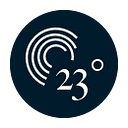#Howto create locator maps with 23degreees.io — PART 2: Filters and Clusters | EN/GER
## für Deutsche Version nach unten scrollen ##
In the last episode we talked about the essential features of our new locator maps. Today we are going to explain to you how you can create filters and how to enable clusters for markers.
Filters
Within our locator maps you can easily create filters by adding what we call categories (e.g. type of location, date, or any other attribution that describes your marker a or a set of markers) to your locator map.
You can then add different characteristics to your category (in this case we use the keywords ‘bar’, ‘restaurant’, ‘shopping’ and ‘gym’ to characterize the four different types of locations that we will be able to choose from in the filter.
- Create a category (e.g. ‘type of location’)
2. Create its characteristics (e.g. ‘bar’, ‘restaurant’, ‘shopping’, ‘gym’)
For this example we wanted to name our characteristics after the actual names of the markers to better illustrate how the filter function works.
3. Select a marker to assign a characteristic
In order to assign a certain characteristic (or more than one) to a marker, first click on the marker and then choose the characteristic you’d like to assign it to. Once both the marker and the characteristic are highlighted in blue they are linked.
4. Enable filter
Go to the filter tab and enable the filter by clicking on the categories that you want to choose as your filter in the map. In this case we only use one category but you could add as many as you like.
Your filter is now working! Choose between multi- or single select to allow filtering for either one or multiple characteristics at the same time.
Clusters
Clusters are helpful if you have a high density of markers on your locator map, which makes it hard to display them all at the same time.
Click on the Cluster tab and then on the Enable button to activate this feature.
Setting the Radius lets you calibrate how many markers will be clustered at which zoom-level. Find two examples of the same locator map below:
The first one with the Radius set low (5).
The second one with the Radius set high at 100.
In addition, there are a myriad of ways to style and and customize clusters, so we suggest you head over to 23degrees.io and try them out right now.
Happy mapping!
Follow us
twitter: @23degrees_io
fb: @23degrees.io
ig: @23degrees_io
## DEUTSCHE VERSION ##
Wie erstelle ich Locator-Maps mit 23degreees.io | TEIL 2: Filter und Cluster
Im letzten Blogpost haben wir die wesentlichen Merkmale unserer neuen Locator-Maps erklärt. Heute werden wir genauer darauf eingehen, wie man Filter erstellen und Cluster für Marker aktivieren kann.
Filter
In unseren Locator-Maps können Filter ganz einfach erstellt werden, indem die Marker Kategorien zugeordnet werden (z. B. Art des Ortes, Datum oder eine andere Beschreibung).
Es können diesen Kategorien dann verschiedene Eigenschaften hinzufügt werden (in diesem Fall verwenden wir die Schlüsselwörter “Bar”, “Restaurant”, “Shopping” und “Gym”, um die vier verschiedenen Arten von Orten zu charakterisieren, aus denen wir später im Filter auswählen können).
- Erstelle eine Kategorie (z.B. ‘Art des Ortes’)
2. Erstelle deren Eigenschaften (z.B. ‘Bar’, ‘Restaurant’, ‘Shopping’, ‘Gym’).
Für dieses Beispiel werden wir unsere Merkmale nach den Namen der Marker benennen, um die Funktionsweise der Filterfunktion besser zu veranschaulichen.
3. Ordne einem Marker eine Eigenschaft zu
Um einem Marker eine bestimmte Eigenschaft (es können aber auch mehrere sein) zuzuordnen, klicke zunächst auf den Marker und wähle dann die Eigenschaft aus, die dem Marker zugeordnet werden soll. Sobald sowohl der Marker als auch die Eigenschaft blau hervorgehoben sind, sind sie verknüpft. In diesem Fall haben wir die Eigenschaft “Restaurant” dem Marker “Restaurant” zugeordnet.
4. Filter einschalten
Gehe zum Tab “Filter” und aktiviere den Filter, indem du auf die Categories klickst, die als Filter in der Karte angezeigt werden sollen. In diesem Fall verwenden wir nur eine Category, man kann allerdings so viele hinzufügen, wie man möchte.
Juhu! Der Filter ist jetzt aktiviert ! Wähle zwischen Mehrfach- oder Einfachauswahl, um entweder nach einem oder mehreren Eigenschaften gleichzeitig zu filtern.
Cluster
Cluster sind hilfreich, wenn sich eine hohe Dichte an Markern auf der Karte befinden und es somit schwierig ist, alle Marker gleichzeitig anzuzeigen.
Klicke auf den Tab Cluster und dann auf die Schaltfläche Enable, um die Cluster Funktion zu aktivieren.
Mit der Einstellung des Radius kann man kalibrieren, wie viele Marker bei welcher Zoomstufe geclustert werden. Nachfolgend sind zwei Beispiele für die selbe Locator-Map angeführt:
Im ersten Beispiel ist der Radius niedrig eingestellt (5).
Hier ist das zweite Beispiel. Der Radius ist nun hoch eingestellt (100).
Es gibt zusätzlich eine Vielzahl von Möglichkeiten zur Gestaltung und Anpassung von Clustern, die ihr am besten gleich auf 23degrees.io ausprobiert!
Viel Spaß beim Erstellen der Locator-Maps!
Folge uns
twitter: @23degrees_io
fb: @23degrees.io
ig: @23degrees_io
